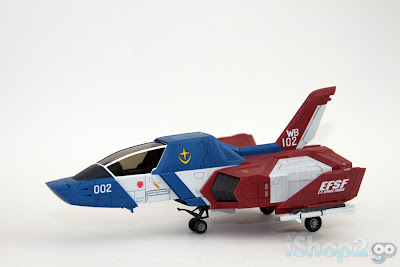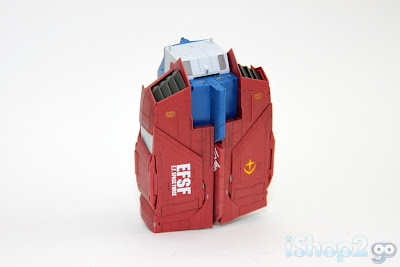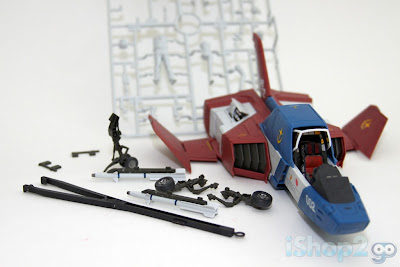The E.F.S.F. Multipurpose Light Fighter FF-X7 Core Fighter is the newest of the U.C. Hardgraph model kit series from Bandai. It was released in February of 2011 for the retail price of 4,500yen. The previous one before the Core Fighter was released more than 2 years ago. This Core Fighter is in 1/35 scale and can transform into a core block. U.C. Hardgraphs are not known for their complexity but instead, they are known for the amount of detail you can add to the kit and it requires a bit of gluing parts together, especially with characters.
Contents of the box includes:
-Foil sticker sheet
-Waterslide decals
-8 Runners (A, B, C, D, E, F, G, H)
Unlike traditional PG, MG, or HG kits, the Core Fighter U.C. Hardgraph is given the waterslide decal bonus so there's no need to purchase separate decal sheets.
Weapons and accessories included are:
-4 small missiles per side (total of 8) hidden within the core block
-2 large missiles that attaches to the bottom of each wing
-Landing gears and wheels
-Wheel stoppers, pully and anchor
-4 character figures
-Connector for Action Base 2
The FF-X7 Core fighter is not a complicated build as it only has a total of 8 runners and many of the pieces are large frames for the kit. There's no inner frame and the panels make up the the core fighter creating hollow cavities throughout the kit. For stability purposes, the kit itself requires the use of glue, especially on each of the characters. Although the pieces are large, there are actually a lot of details engraved and embossed on the plastic allowing for hand painting and panel line wash. If you do not plan to paint the kit itself but would like to add details, the panel line wash method works best. To perform the panel line wash on bare plastic, personally, I used a water-based/alcohol-soluble paint, thinned it and painted all the grooves with black paint. Once it's been dried, I dampen a piece of tissue with alcohol and just wiped the plastic down. By performing this panel line wash method, it cleans up the paint on the surface of the plastic while leaving the paint embedded inside the grooves of the panel lines. (This is just my method of performing panel line wash. There are plenty of other tutorials on youtube and the web on how others do it as well.)
Due to the requirement of gluing certain parts together, there is very limited articulation. But the kit itself does transform between flight mode and core block mode. The cockpit shield is a smoke clear color and can be pushed back to review an open cockpit. The seat itself tilts back as the core fighter is transformed into a core block. The transformation itself is simple which only requires pushing the front portion of the core fighter in, folding it backwards, folding the two wings in, and dropping the back wing down. The landing gears and wheels itself are not built into the kit and cannot fold out. Instead, you have to manually open the panels and parts swap them in and out when posing the different modes. As for the character figures, there's an actual pilot that can sit in the cockpit, a standing Amuro Ray and Sayla mass, and a deck crew personel.
If you plan to pose the core fighter in mid-flight, you can use the connector and place the kit itself on an Action Base 2. Unfortunately in core block mode, the front tip of the core fighter is a bit longer than the whole core block itself and therefore will not stand flat, but instead, slightly tilted. For the waterslide decals, there are 3 variations for you to use. The first is for Amuro Ray, the second is for Sayla Mass, and the third variation is for the G3. Due to the lack of color variation for the plastic, this kit would greatly benefit with some paint detailing, panel lining, and a flat/matte top coat to get rid of the plastic feel and look of the kit.
In summary, although there are less runners than your typical Master Grade model kit, the FF-X7 Core Fighter requires more time and effort for it to look comparable to a straight out of box build of a MG kit. This is mainly due to the requirement of gluing some parts together, lack of color separation in some areas, especially a solid color for the character figures, and the significant number of important decals for details to make it anime accurate. Hand painting the details of the kit would also be required to make the kit look good. One unfortunate issue with the kit is that there are some loose pieces that likes to pop off. But if you were to glue them in place, it would prevent the kit from transforming between the different modes. That is my only issue with the kit. But if you plan to never transform the kit and keep it in a single mode, then this would be no issue at all. If you are willing to invest some time and energy to make this kit look nice, this kit is definitely worth picking up and becoming one of the center pieces of your collection.
you can visit:

Bandai U.C. Hard Graph FF-X7 Core Fighter



No comments:
Post a Comment